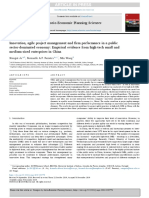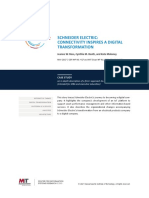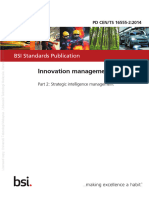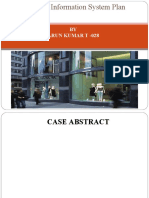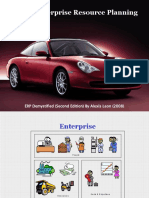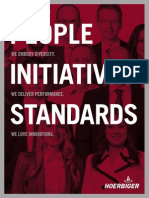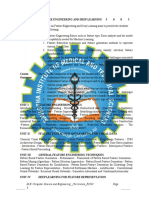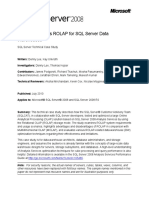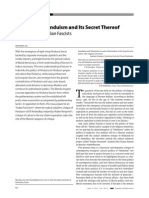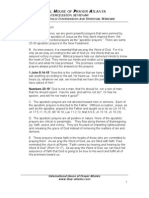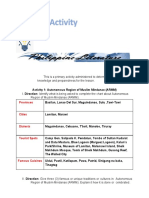4d. Ross 2005 PDF
4d. Ross 2005 PDF
Uploaded by
Bernie ClintonCopyright:
Available Formats
4d. Ross 2005 PDF
4d. Ross 2005 PDF
Uploaded by
Bernie ClintonOriginal Title
Copyright
Available Formats
Share this document
Did you find this document useful?
Is this content inappropriate?
Copyright:
Available Formats
4d. Ross 2005 PDF
4d. Ross 2005 PDF
Uploaded by
Bernie ClintonCopyright:
Available Formats
Center for Information Systems Research
Sloan School of Management
Massachusetts Institute of Technology
RESEARCH BRIEFING
Volume V
Number 3C
FORGET STRATEGY:
FOCUS IT ON YOUR OPERATING MODEL
Jeanne W. Ross, Principal Research Scientist
MIT Center for Information Systems Research
Most companies try to maximize value from IT investments by aligning IT and IT-enabled business
processes with business strategy. But business strategy is multi-faceted, encompassing decisions as to
which markets to compete in, how to position the
company in each market, and which capabilities to
develop and leverage. In addition, strategic priorities
can shift as companies respond to competitor initiatives or seize new opportunities. As a result, strategy
rarely offers sufficiently clear direction for development of stable IT and business process capabilities. IT is left to align with individual strategic initiativesafter they are announced. Thus, IT becomes a
persistent bottleneck.
To make IT a proactiverather than reactiveforce
in creating business value, companies should define
an operating model. An operating model is the necessary level of business process integration and
standardization for delivering goods and services to
customers. By identifying integration and standardization requirements an operating model defines critical IT and business process capabilities. This briefing explores how a companys operating model
guides IT investment and enhances business agility.1
Four Alternative Operating Models
Companies make two important choices in the design of their operations: (1) how standardized their
business processes should be across operational
units (business units, region, function, market segment) and (2) how integrated their business
processes should be across those units. In making
these two choices, company management is targeting one of four operating models (as shown in Figure 1):
1
December 2005
Diversification (low standardization,
low integration)
Unification (high standardization,
high integration)
Coordination (low standardization,
high integration)
Replication (high standardization,
low integration)
All four operating models represent viable alternatives for delivering goods and services to a companys customers.
The Diversification model is a decentralized organizational design. Business units pursue different markets with different products and services, and benefit
from local autonomy in deciding how to address
customer demands. Carlson, a $20B company of
related but autonomous hospitality businesses, is an
example of a Diversification model.
The Unification model describes a centralized organizational design. The company pursues the need for
reliability, predictability and low cost by standardizing
business processes and sharing data across business
units to create an end-to-end view of operations and a
single face to the customer. Delta Air Lines standardized global business is an example of Unification.
The Coordination model focuses on integration. A
Coordination model company creates a single face to
its customers or a transparent supply chain without
forcing specific process standards on its operating
units. Toyota Europe, for example, shares product
data across country business units so they can rapidly exchange automobiles and parts to meet customer
needs.
The Replication model focuses on process standardization. Operating units perform tasks the same way
using the same systems so that they can generate
global efficiencies and brand recognition. However,
operating units rarely interact. As an example, Marriott replicates systems and processes related to a
wide range of processes, including reservations, frequent guest rewards, wake-up calls and revenue planning in each of its independently managed hotels.
This briefing expands on concepts originally described
in Aligning IT Architecture with Organizational Realities, CISR Research Briefing Vol. III, No. 1A, March
2003.
2005 MIT Sloan CISR, Ross. CISR Research Briefings are published three times per year to update CISR patrons, sponsors & other supporters on current CISR research projects.
CISR Research Briefing, Vol. V, No. 3C
Implications for IT Investment
By identifying the intended level of business process
integration and standardization, the operating model
determines priorities for development of digital capabilities and thus IT investment. Accordingly, IT investments not only address immediate business needs,
they digitize key business capabilities, thereby building a foundation for future business initiatives.
For example, CEMEX, a Replication company, has
built a foundation based on process standardization.
CEMEX has standardized eight key business
processes: commercial (customer facing and cement
logistics), ready mix manufacturing, accounting,
planning and budgeting, operations, procurement,
finance, and HR. Although the businesses reuse
processes, they do not typically share dataeach
business is run autonomously. CEMEX has leveraged its IT-enabled standardized processes in assimilating acquisitions. For example, in 2000,
CEMEX acquired Southland, the U.S.s second largest cement manufacturer, and completed assimilation
in four months. Subsequent acquisitions have been
assimilated in as little as two months.2
While CEMEX has built standardized processes,
Merrill Lynchs Global Private Client (GPC) business
has built a foundation of digitized processes to support a Coordination model. GPCs business objective
is to provide a wide range of investment products to
wealthy clients across a variety of channels (e.g. interactions with a financial advisor, online access, telephone access).3 To meet this objective, GPC developed integrated product data and standardized
customer interfaces on its Total MerrillSM platform.
But GPC does not typically standardize business
processes across the globe. GPC leverages these IT
capabilities every time it introduces a new investment
product or creates a new channel for accessing its
products. As a result of GPCs standard technology
platform and access to shared business data, the company has the best revenue per advisor, earnings per
advisor and assets per advisor in the industry.4
As a Unification company, Dow Chemical seeks
both integration and standardization to achieve effi-
Page 2
December 2005
ciencies and meet the demands of global customers.
Dow uses a single instance of SAP to support highly
standardized core processes (e.g., manufacturing,
finance, logistics) while creating a global supply
chain. Dow has leveraged these capabilities to grow
profitably both organically and through acquisitions.
From 1994 to 2004, despite a downturn in the market, Dow nearly doubled its revenues while growing
its employee base less than 10%a productivity
improvement of eight percent per year.5
By purposely not creating shared digital capabilities,
the Diversification model encourages organic growth
of individual business units and poses unlimited opportunities for growth through acquisition. But because Diversification leverages fewer capabilities
than the other models, companies need to find synergies to create shareholder value. Some Diversification
companies are introducing shared services to gain
economies of scale; others are diversifying into closely related businesses to feed a core business. For example, with its package delivery business at its core (a
Unification model), UPS has diversified into a set of
smaller, growth oriented businesses such as UPS
Supply Chain Solutions, UPS Capital Corporation,
UPS Consulting, The UPS Store, and UPS Professional Services. These new businesses cannot reuse
the existing IT and business process foundation because they operate differently, but they have become
profitable in their own right while adding value by
feeding the core business. As a result, UPS has continued to grow while boasting an operating margin
nearly three times the industry average.
Choosing an Operating Model
Although most companies can identify processes
fitting every operating model, they need to select a
single operating model to guide management thinking and system implementations. Management can
then organize business unit and IT responsibilities
based on principles about how the company will operate most of the time. One way companies respond
to conflicting demands is to adopt different operating models at different organizational levels.
For example, Johnson & Johnson has long operated
in the Diversification quadrant.6 But J&Js U.S.
Rebecca Chung, Donald Marchand and William Kettinger, The CEMEX Way: The right balance between local
business flexibility and global standardization, IMD
International Institute for Management 2005. IMD-31341.
3
V. Kastori Rangan and Marie Bell, Merrill Lynch: Integrated Choice, Harvard Business School case 9-500090, March 2001.
4
Merrill Lynch 2004 Annual Report.
Jeanne W. Ross and Cynthia M. Beath, The Federated
Broker Model at The Dow Chemical Company: Blending
World Class Internal and External Capabilities, MIT
Sloan CISR Working Paper No. 355, July 2005.
6
See Jeanne W. Ross, Johnson & Johnson: Building an
Infrastructure to Support Global Operations, MIT Sloan
CISR Working Paper No. 283, September 1995.
CISR Research Briefing, Vol. V, No. 3C
Page 3
pharmaceutical group applies a Coordination model
to present a single face to health care professionals.
In Europe, Janssen Pharmaceutical Products applies
a Replication model providing low-cost, standardized processes for drug marketing, delivery and
monitoring. Targeting different operating models at
different organizational levels allows J&J to meet
the multiple objectives of a large, complex company,
while keeping organizational design reasonably simple at the individual operating company level.
Our research has found a strong preference across
companies and industries for the Unification model.
Data collected at 103 companies in 2004 indicated
that 63% of companies were targeting Unification.
Only nine percent were targeting Diversification;
17% were targeting Coordination; and 11% were
targeting Replication operating models. The appeal
of the Unification model is that it provides a thick
foundation of digital capabilities to leverage in future business initiatives. However, implementing
that foundation requires a great deal of time, money
and management focus.
In contrast, the off-diagonal operating models
(Coordination and Replication) require less time for
building capabilities before companies can start
reusing them. These off-diagonal models abandon
the centralization-decentralization tradeoffs by allocating different decision rights to the center and the
business units. In a Replication model, local managers must accept enterprise-wide process standards,
December 2005
but they have the autonomy to manage customer
relationships locally. In a Coordination model, local
managers accept enterprise-wide data standards and
customer interfaces, but they have the autonomy to
develop products and processes to achieve local
business objectives. Companies should recognize
that each operating model creates opportunitiesbut
also creates limitations.
Making a Commitment
The operating model concept requires that management put a stake in the ground and declare which
business processes will distinguish a company from
its competitors. A poor choice of operating model
one that is not viable in a given marketwill have
dire consequences. But not choosing an operating
model is just as risky. Without a clear operating model, management careens from one market opportunity
to the next, not leveraging reusable capabilities.
In adopting an operating model a company benefits
from a paradox: standardization leads to flexibility.
By building a foundation of standardized technology, data and/or processes, our research shows a
company achieves more business agility and responds to new market opportunities faster than its
competitors. Admittedly, most companies will need
to regularly experiment with initiatives that do not
leverage their foundation. But an operating model
provides needed direction for building a reusable
foundation for business execution. IT becomes an
asset instead of a bottleneck.
Figure 1: Characteristics of Four Operating Models
Coordination
Business Process Integration
High
Unification
Shared customers, products or suppliers
Impact on other business unit transactions
Operationally unique business units or
functions
Autonomous business management
Business unit control over business process
design
Shared customer/supplier/product data
Consensus processes for designing IT
infrastructure services; IT application
decisions are made in business units
Diversification
Low
Few, if any, shared customers or suppliers
Independent transactions
Operationally unique business units
Autonomous business management
Business unit control over business process
design
Few data standards across business units
Most IT decisions made within business
units.
Replication
Low
Customers and suppliers may be local or global
Globally integrated business processes often with
support of enterprise systems
Business units with similar or overlapping operations
Centralized management often applying
functional/process/business unit matrices
High-level process owners design standardized
process
Centrally mandated databases
IT decisions made centrally
Few, if any, shared customers
Independent transactions aggregated at a high level
Operationally similar business units
Autonomous business unit leaders with limited
discretion over processes
Centralized (or federal) control over business process
design
Standardized data definitions but data locally owned
with some aggregation at corporate
Centrally mandated IT services
High
Business Process Standardization
About the MIT Sloan Center for Information Systems Research
MIT SLOAN CISR MISSION
CISR RESEARCH PATRONS
MIT CISR was founded in 1974 and has a strong track
record of practice-based research on the management of
information technology. MIT CISRs mission is to
perform practical empirical research on how firms
generate business value from IT. MIT CISR disseminates this research via electronic research briefings,
working papers, research workshops and executive
education. Our research portfolio includes but is not
limited to the following topics:
The Boston Consulting Group, Inc.
BT Group
DiamondCluster International, Inc.
Gartner
Hewlett-Packard Company
Microsoft Corporation
Tata Consultancy Services America
CISR SPONSORS
IT Governance
Enterprise Architecture
IT-Related Risk Management
IT Portfolios and IT Savvy
Operating Model
IT Management Oversight
Business Models
IT-Enabled Change
IT Innovation
Business Agility
The IT Engagement Models
In July of 2008, Jeanne W. Ross succeeded Peter Weill
as the director of CISR. Peter Weill became chairman
of CISR, with a focus on globalizing MIT CISR research and delivery. Drs. George Westerman, Stephanie
L. Woerner, and Anne Quaadgras are full time CISR
research scientists. MIT CISR is co-located with MIT
Sloans Center for Digital Business and Center for
Collective Intelligence to facilitate collaboration between
faculty and researchers.
MIT CISR is funded by Research Patrons and Sponsors
and we gratefully acknowledge the support and contributions of its current Research Patrons and Sponsors.
CONTACT INFORMATION
Center for Information Systems Research
MIT Sloan School of Management
5 Cambridge Center, NE25, 7th Floor
Cambridge, MA 02142
Telephone: 617-253-2348
Facsimile: 617-253-4424
Email: cisr@mit.edu
http://mitsloan.mit.edu/cisr
Mission and Contact Information as of August 1, 2009.
Aetna Inc.
Allstate Insurance Company
American Express Corporation
AstraZeneca Pharmaceuticals, LP
Biogen Idec
Campbell Soup Company
CareFirst Blue Cross Blue Shield
Care USA
Celanese
Chevron Corporation
Det Norske Veritas (Norway)
Direct Energy
eFunds Corporation
EMC Corporation
Guardian Life Insurance Company
of America
ING Groep N.V.
Intel Corporation
International Finance Corporation
Merrill Lynch & Co., Inc.
MetLife
Mohegan Sun
Motorola, Inc.
Nomura Research Institute, Ltd.
Pasco County, Florida
PepsiAmericas, Inc.
Pfizer, Inc.
PFPC, Inc.
Raytheon Company
State Street Corporation
TD Banknorth
Telenor ASA
Trinity Health
TRW Automotive, Inc.
United Nations DESA
US Federal Aviation Administration
You might also like
- Full Cloud Computing: Concepts, Technology, Security & Architecture Thomas Erl & Eric Barceló Monroy Ebook All ChaptersDocument49 pagesFull Cloud Computing: Concepts, Technology, Security & Architecture Thomas Erl & Eric Barceló Monroy Ebook All ChaptersnurimgrabowNo ratings yet
- Operation and Maintenance Manual: Cab S/N 3648 12001 & AboveDocument111 pagesOperation and Maintenance Manual: Cab S/N 3648 12001 & AboveAaron Vance100% (1)
- Scaled Agile Framework Implementation in Organizations', Its Shortcomings and An AI Based Solution To Track Team's PerformanceDocument7 pagesScaled Agile Framework Implementation in Organizations', Its Shortcomings and An AI Based Solution To Track Team's PerformanceMushlih RidhoNo ratings yet
- Industry 4 With SapDocument44 pagesIndustry 4 With SapSuvendu BishoyiNo ratings yet
- Customer Satisfaction On Big Brew Milktea ShopDocument12 pagesCustomer Satisfaction On Big Brew Milktea Shopkenneth coronel100% (1)
- Handbook of Data Quality Research and Practice (Shazia Sadiq)Document440 pagesHandbook of Data Quality Research and Practice (Shazia Sadiq)Claudio PeñaNo ratings yet
- Pearson Case StudyDocument12 pagesPearson Case Studymelissa_infusionNo ratings yet
- Jeanne Ross 01 08 2007 EADocument23 pagesJeanne Ross 01 08 2007 EAScribd-access100% (1)
- BigQuery ML DocumentationDocument2 pagesBigQuery ML DocumentationThursy SatrianiNo ratings yet
- ITM CaseDocument10 pagesITM CasePramod JuyalNo ratings yet
- Anticipate Industry Disruption Take Your IT to the Next LevelFrom EverandAnticipate Industry Disruption Take Your IT to the Next LevelNo ratings yet
- MIT CISR Wp397 DemandShapingSurveyDocument13 pagesMIT CISR Wp397 DemandShapingSurveyAldus PagemakerNo ratings yet
- CISR Research Briefings 2006Document0 pagesCISR Research Briefings 2006Vanessa Gómez LondoñoNo ratings yet
- Digitized DigitalDocument4 pagesDigitized DigitalAbhishekKumarNo ratings yet
- PCF - Petroleum Upstream - Ver - 5.1.0 PDFDocument18 pagesPCF - Petroleum Upstream - Ver - 5.1.0 PDFandhika_sotaxNo ratings yet
- Embrace The Inevitable - Six Imperatives To Prepare Your Company For Cloud ComputingDocument4 pagesEmbrace The Inevitable - Six Imperatives To Prepare Your Company For Cloud ComputingswainanjanNo ratings yet
- PCF Consumer Electronics Ver 6.0.0Document35 pagesPCF Consumer Electronics Ver 6.0.0carebeardancer5678No ratings yet
- Visual Study Notes For Human Resources 61e93e2fc0a05Document19 pagesVisual Study Notes For Human Resources 61e93e2fc0a05Vasili VertsonisNo ratings yet
- Lego DXDocument17 pagesLego DXjenillebarberomatiasNo ratings yet
- 2002 MSB Magazine Spring SummerDocument32 pages2002 MSB Magazine Spring Summertmm53No ratings yet
- Innovation Agile Project Management and Firm Performance in - 2019 - Socio EconDocument14 pagesInnovation Agile Project Management and Firm Performance in - 2019 - Socio EconAmin HilaliNo ratings yet
- Conceptual Modeling For Information SystemsDocument28 pagesConceptual Modeling For Information SystemsgabilasticNo ratings yet
- Project ManagementDocument592 pagesProject Managementsidharath.gautam89No ratings yet
- Schneider Electric: Connectivity Inspires A Digital TransformationDocument14 pagesSchneider Electric: Connectivity Inspires A Digital TransformationPrakashNo ratings yet
- Chap 07Document213 pagesChap 07Mayuri Bhavnani BhatiaNo ratings yet
- Introduction To fs/QCADocument27 pagesIntroduction To fs/QCAΤάσος ΚυριακίδηςNo ratings yet
- 7 Leading Machine Learning Use CasesDocument11 pages7 Leading Machine Learning Use CasesOnline ServicesNo ratings yet
- 2nd Day MOH-EA ShahrinDocument38 pages2nd Day MOH-EA ShahrinRazale Ibrahim100% (1)
- Migrating Applications To TH 207162Document45 pagesMigrating Applications To TH 207162Cristiano MarquesNo ratings yet
- Living in A World of Low Levels of Predictability International Journal of Forecasting With N. TalebDocument5 pagesLiving in A World of Low Levels of Predictability International Journal of Forecasting With N. TalebPaulNo ratings yet
- Source Processes CSCMPDocument32 pagesSource Processes CSCMPFabian Leonardo Chavez MartinezNo ratings yet
- Enterprise Architecture Quality Attributes: A Case StudyDocument12 pagesEnterprise Architecture Quality Attributes: A Case StudyAditya MaulanaNo ratings yet
- Celonis PQL Chapter-WebDocument34 pagesCelonis PQL Chapter-WebDeno DeviNo ratings yet
- Unlock The Potential of Digitalization: Prakash Chandran President Director & CEO, Siemens IndonesiaDocument10 pagesUnlock The Potential of Digitalization: Prakash Chandran President Director & CEO, Siemens IndonesiaAgung SupriyantoNo ratings yet
- Mejora ContinuaDocument14 pagesMejora ContinuaCharly PerezNo ratings yet
- Meridium APM Now: Questions?Document2 pagesMeridium APM Now: Questions?SANDRA TORRESNo ratings yet
- Certified Software Business AnalystDocument6 pagesCertified Software Business Analysttechieaman100% (1)
- Artificial Intelligence For Software Development The Present and The ChallengesDocument18 pagesArtificial Intelligence For Software Development The Present and The ChallengesToluwalope GloriaNo ratings yet
- Main Finance Sample Report (2010)Document29 pagesMain Finance Sample Report (2010)Nibras Hussein MohammedNo ratings yet
- PLM IntroDocument33 pagesPLM IntroGeetanjali100% (1)
- Augmented Analytics EbookDocument17 pagesAugmented Analytics EbookMaria Madalina TurbatuNo ratings yet
- Data Management Plan Template He enDocument6 pagesData Management Plan Template He eneftychidisNo ratings yet
- 4 Rolls Royce Case StudyDocument4 pages4 Rolls Royce Case StudySyed Osama Ali ShahNo ratings yet
- Us Traceability in The Food Value ChainDocument10 pagesUs Traceability in The Food Value ChainSoufiane BenbouazzaNo ratings yet
- Mobile Agent-Based SoftwareDocument15 pagesMobile Agent-Based SoftwareAmmar BoucheritNo ratings yet
- Data As A Service The Future of Data ManagementDocument7 pagesData As A Service The Future of Data ManagementKOLLIE FLOMONo ratings yet
- PD Cen-Ts 16555-2-2014 - (2016-05-23 - 10-03-37 PM)Document22 pagesPD Cen-Ts 16555-2-2014 - (2016-05-23 - 10-03-37 PM)ahmedNo ratings yet
- BPM Aris Part1Document10 pagesBPM Aris Part1smallik3No ratings yet
- Erp Keda Sap ImplementationDocument28 pagesErp Keda Sap ImplementationAksa DindeNo ratings yet
- Knowledge Engineering ManagementDocument90 pagesKnowledge Engineering Managementaustinfru50% (2)
- Qlik Sense Cmdlet For Powershell: Sokkorn CheavDocument11 pagesQlik Sense Cmdlet For Powershell: Sokkorn CheavIvan ShamaevNo ratings yet
- Direction of Agile BI Analytics Big DataDocument26 pagesDirection of Agile BI Analytics Big DataSergei OssifNo ratings yet
- Enterprise Resource Planning: ERP Demystified (Second Edition) by Alexis Leon (2008)Document38 pagesEnterprise Resource Planning: ERP Demystified (Second Edition) by Alexis Leon (2008)Suneela MatheNo ratings yet
- Data Transformation and Arima Models A SDocument8 pagesData Transformation and Arima Models A SMary BojanNo ratings yet
- Ausgabe PDFDocument136 pagesAusgabe PDFkani_ravi9No ratings yet
- Feature Engineering and Deep LearningDocument2 pagesFeature Engineering and Deep LearningHRIDYA VENUGOPAL CSENo ratings yet
- Ssas Rolap For SQL ServerDocument42 pagesSsas Rolap For SQL ServerCuervito NuNo ratings yet
- A Framework To Review Performance Measurement SystemsDocument14 pagesA Framework To Review Performance Measurement SystemsrezasattariNo ratings yet
- Follow These Steps To Export and Import A Web Content LibraryDocument4 pagesFollow These Steps To Export and Import A Web Content LibrarytinceevermaNo ratings yet
- Amarnath Gupta, Ramesh Jain - Managing Event Information - Modeling, Retrieval, and Applications - Morgan & Claypool (2011) PDFDocument143 pagesAmarnath Gupta, Ramesh Jain - Managing Event Information - Modeling, Retrieval, and Applications - Morgan & Claypool (2011) PDFGabriel RodeNo ratings yet
- 5. CHAPTER 2Document7 pages5. CHAPTER 2K K LwinNo ratings yet
- MicrobiologiaDocument30 pagesMicrobiologiaGabriel MonteiroNo ratings yet
- Pipeline Builder: Best Practice GuideDocument9 pagesPipeline Builder: Best Practice Guidenikki ZhangNo ratings yet
- What Is Foreign Trade Policy?Document12 pagesWhat Is Foreign Trade Policy?Nabajyoti SonowalNo ratings yet
- KONA Micro 2.0 Quick Start GuideDocument4 pagesKONA Micro 2.0 Quick Start GuideLuiz FilgueirasNo ratings yet
- Case Incident 1: The Calamities of Consensus: Submitted By: Prashant Kumar (P40193)Document1 pageCase Incident 1: The Calamities of Consensus: Submitted By: Prashant Kumar (P40193)Nikku SinghNo ratings yet
- Ocean WebquestDocument6 pagesOcean Webquestbooneladanian8No ratings yet
- CD - Câu Tường ThuậtDocument9 pagesCD - Câu Tường ThuậtPhạm Minh ThảoNo ratings yet
- Download ebooks file Statics and Mechanics of Materials in SI Units Fifth Edition Russell C. Hibbeler all chaptersDocument65 pagesDownload ebooks file Statics and Mechanics of Materials in SI Units Fifth Edition Russell C. Hibbeler all chaptersvelhowotheab33% (3)
- TH-878 - Bearing Pressure Effect Due To Foudnation Size PDFDocument74 pagesTH-878 - Bearing Pressure Effect Due To Foudnation Size PDFSubashini JaganathanNo ratings yet
- Theory NotesDocument7 pagesTheory NotesThe Xplorer In Me CooksNo ratings yet
- Fetishism of Hinduism and Its Secret ThereofDocument9 pagesFetishism of Hinduism and Its Secret ThereofomnepNo ratings yet
- Police PowerDocument7 pagesPolice PowerErwin James Badayos FabrigaNo ratings yet
- Number Theory and CryptographyDocument26 pagesNumber Theory and CryptographyanshulNo ratings yet
- Aklatang Obrero - Ka Popoy - Working Class Hero PDFDocument2 pagesAklatang Obrero - Ka Popoy - Working Class Hero PDFAngelito Dela Cruz100% (2)
- Tgas 1Document7 pagesTgas 1Muh Fajar Eka PutraNo ratings yet
- Chapter 3 - LevelingDocument6 pagesChapter 3 - LevelingjethcahfayeregisalcantaraNo ratings yet
- Collections and Java8Document114 pagesCollections and Java8singhnikhilsingh21No ratings yet
- Mohammad Agung Pratama - English IDocument2 pagesMohammad Agung Pratama - English ISigit PamungkasNo ratings yet
- PDF Expert GuíaDocument59 pagesPDF Expert GuíaJordan FonsecaNo ratings yet
- Mixed Conditionals PDFDocument4 pagesMixed Conditionals PDFMontse López LópezNo ratings yet
- Noting DetailsDocument14 pagesNoting DetailsLhorz Cordel ParabolesNo ratings yet
- Mega-Floaters: Aircushjon SupportedDocument159 pagesMega-Floaters: Aircushjon SupportedEnriqueNo ratings yet
- 3 - Apostolic Intercession & Spiritual WarfareDocument8 pages3 - Apostolic Intercession & Spiritual WarfareTotalPraise100% (1)
- PowertranzSimplified3DSAPI V 2.4Document31 pagesPowertranzSimplified3DSAPI V 2.4ludwinsNo ratings yet
- BUCOT, Maria Alizah L. Bsa 4A 2 Midterm Activity - HBO 1. Miscommunication/ Misunderstanding (20 PTS)Document3 pagesBUCOT, Maria Alizah L. Bsa 4A 2 Midterm Activity - HBO 1. Miscommunication/ Misunderstanding (20 PTS)Alizah BucotNo ratings yet
- Chapter Vii - Preactivity - Literature in Armm and Zamboanga PeninsulaDocument4 pagesChapter Vii - Preactivity - Literature in Armm and Zamboanga PeninsulaGian Russel Ilao100% (1)
- Justin Riccio Portfolio Resume 2Document1 pageJustin Riccio Portfolio Resume 2api-705558230No ratings yet
- 1.2 Health Care Delivery SystemDocument53 pages1.2 Health Care Delivery Systemsefal mansuri100% (3)




















